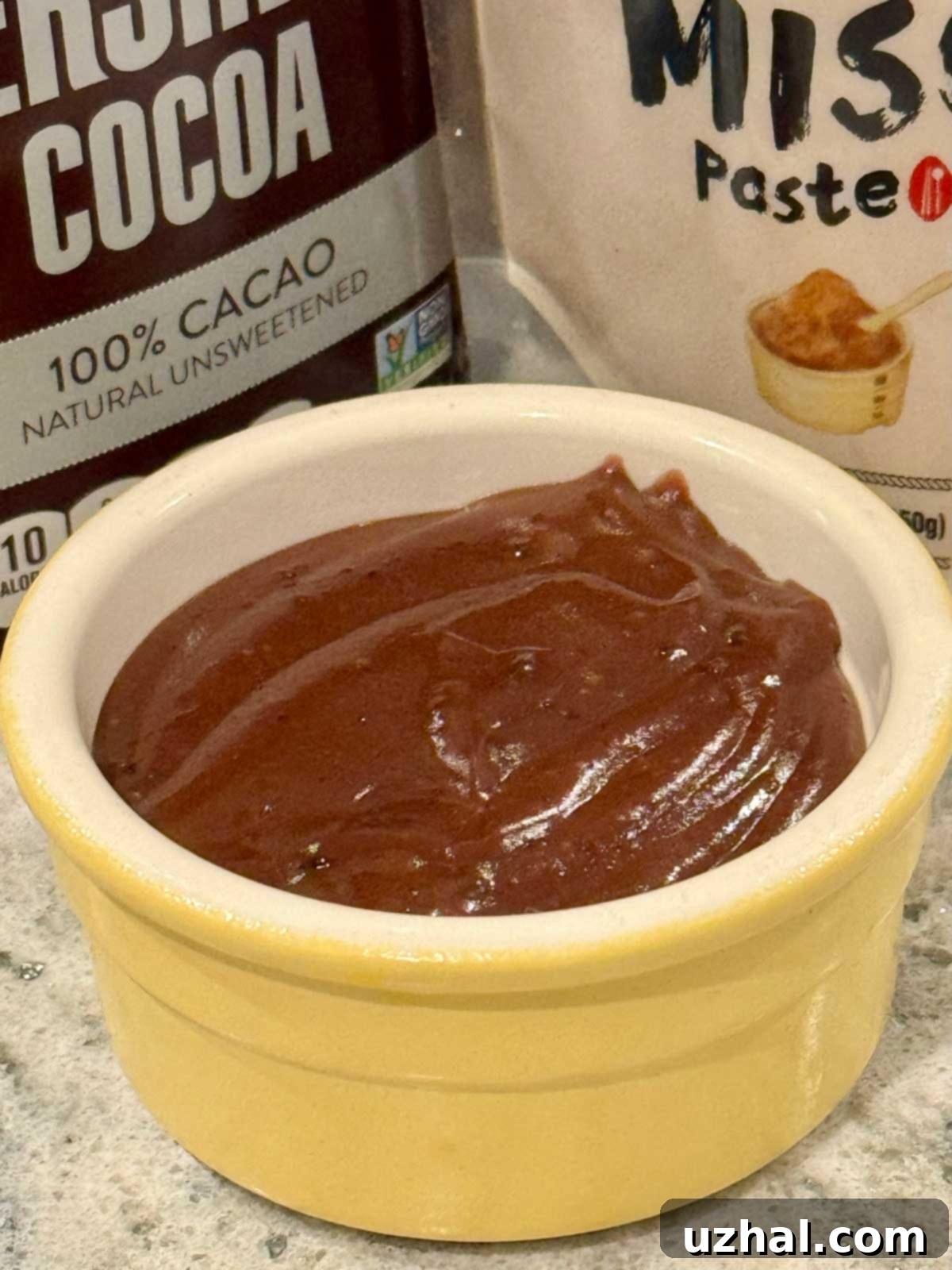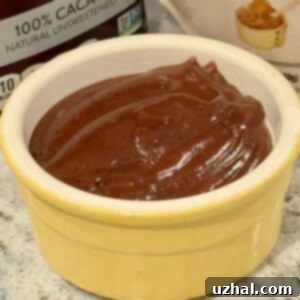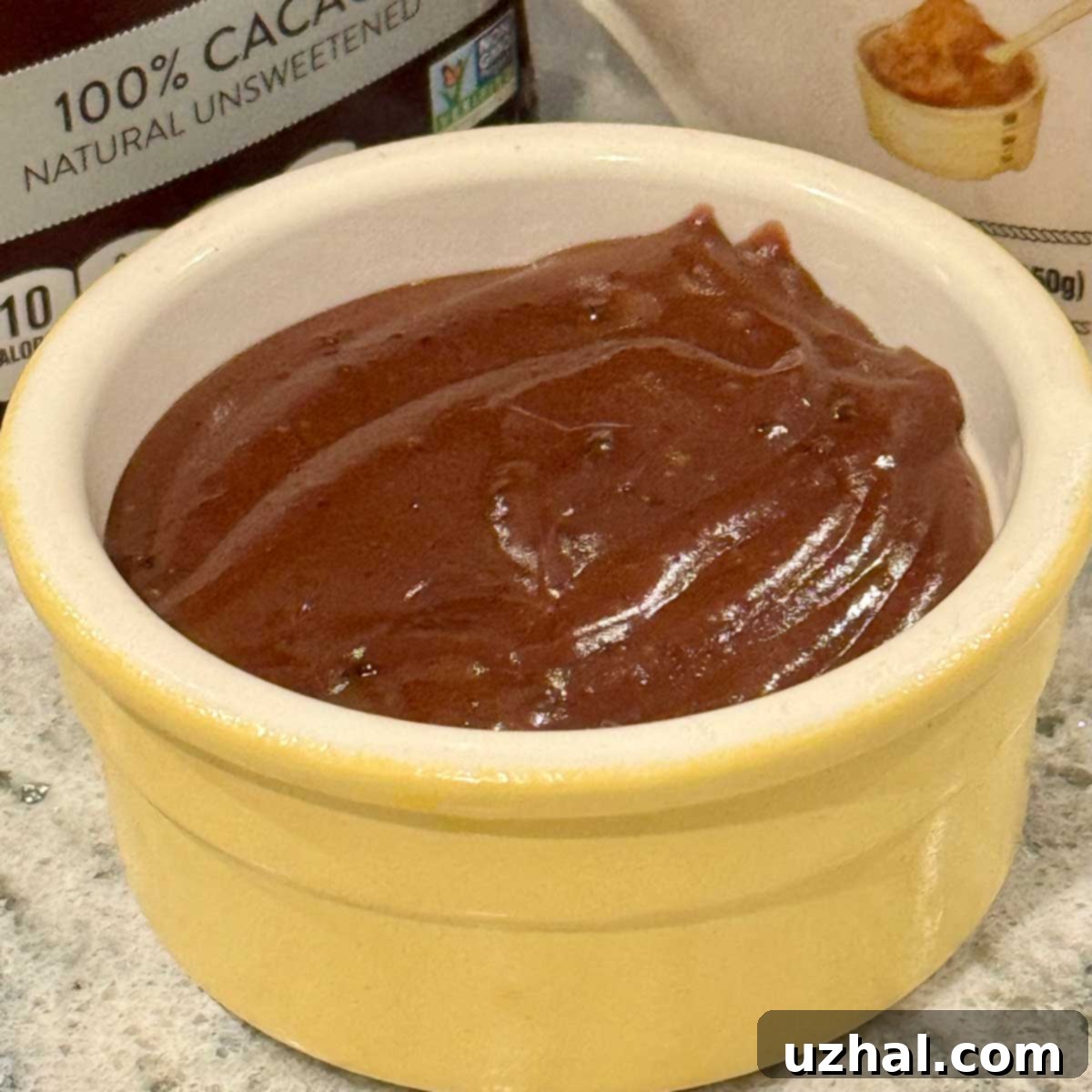Decadent Miso Chocolate Pudding: A Rich and Easy Dessert with an Umami Boost
Having previously ventured into the delightful world of Miso Chocolate Chip Cookies, my culinary curiosity was piqued, leading me to explore miso paste’s incredible potential in other sweet treats. The latest, and arguably most captivating, experiment was this Miso Chocolate Pudding. It’s a surprisingly simple stovetop pudding recipe, crafted with familiar ingredients, but elevated by a secret addition: a touch of delicate white miso. This innovative approach naturally leads to the intriguing question: does miso truly belong in a classic chocolate pudding, and what magic does it bring?

The Unexpected Harmony: Why Miso Elevates Chocolate Pudding
For those unfamiliar with this versatile ingredient, miso is a traditional Japanese seasoning made from fermented soybeans, salt, and koji (a type of fungus). Its texture is a thick paste, and its flavor spectrum is vast, ranging from subtly sweet and mild to intensely salty and robust, depending on the fermentation period. In the realm of miso, white miso (shiro miso) stands out as the mildest variety. To many, its taste evokes a softer, less assertive version of soy sauce, with a hint of sweetness and a rich, underlying umami profile. When incorporating miso into chocolate pudding, the goal isn’t to impart a distinct “miso flavor.” Instead, it acts as a masterful background note, designed to amplify and deepen the inherent flavors of the chocolate and other ingredients, much like a pinch of salt enhances sweetness. For this particular application, a mild white miso paste is absolutely essential, as stronger varieties could overpower the delicate balance. I found an excellent white miso in a convenient pouch at Trader Joe’s, but many Asian grocery stores or even well-stocked supermarkets carry suitable options. This brings us back to the core question: why go to the trouble of adding miso when alternatives like soy sauce or coffee might seem simpler?
The Secret Ingredient Revelation: Experiencing the Miso Difference
Beyond the simple allure of having a “secret ingredient” to intrigue your guests, the true justification for adding miso lies in the remarkable enhancement it brings to the chocolate pudding. While a classic chocolate pudding is undoubtedly delicious on its own, the miso introduces a subtle complexity and richness that truly transforms it. My own unscientific, yet telling, experiment involved creating two batches of pudding. As I tasted the miso version throughout the cooking process, I wasn’t entirely convinced of its impact. So, I prepared a second batch, substituting the miso and water mixture with ¼ cup of brewed coffee, a known chocolate enhancer. The next day, with a refreshed palate, I conducted a side-by-side taste test. Both puddings were exceptionally good, but the miso-infused version possessed an undeniable depth, an almost fudge-like intensity, that made the chocolate flavor more pronounced and vibrant. It felt richer, more rounded, and simply more decadent. My internal monologue confirmed what my taste buds were telling me. The definitive validation, however, came from my husband, who, completely unaware of the miso, spontaneously declared, “this is really good.” That’s the power of miso in this context – it doesn’t announce itself with a distinct flavor, but rather elevates the chocolate to new heights, creating a truly memorable dessert experience.
Crafting the Perfect Chocolate Pudding: A Foundation of Flavor and Technique
While this recipe features a unique ingredient, at its heart, it’s a testament to the timeless appeal of homemade chocolate pudding. Over the years, I’ve collected numerous chocolate pudding recipes, and they all share fundamental similarities, with subtle variations in ratios and techniques. The truly exceptional ones, much like this recipe, strike a perfect balance by incorporating both rich cocoa powder and luxurious melted chocolate. This dual approach ensures a profound chocolate flavor that is both deep and nuanced, avoiding the one-dimensional taste that can sometimes plague single-source chocolate desserts. Numerous variables can influence the final taste and texture of your pudding, from the type and quality of cocoa powder (Dutch-processed offers a darker color and milder flavor, while natural cocoa is more acidic and fruity) and the specific kind of melted chocolate you choose (bittersweet chocolate provides complexity, while semi-sweet adds a touch more sweetness) to the fat content of your milk (whole milk yields the creamiest result) and the precision of your cooking method. Given these factors, it’s entirely natural for every homemade pudding to taste subtly different, even when adhering to the same recipe. This pudding is wonderfully adaptable; I could easily make variations of it for a week straight. My next culinary exploration? Swapping out the miso for a splash of bourbon, promising another exciting twist on this beloved classic.
Unlocking Umami: A Game-Changer for Sweet Creations
Umami, often described as the fifth basic taste alongside sweet, sour, salty, and bitter, is a profoundly savory sensation that adds depth and richness to food. While typically associated with savory dishes like broths, mushrooms, and aged cheeses, its application in desserts is a growing trend that can truly elevate a dish from good to extraordinary. Miso, rich in glutamates, is a fantastic source of umami. When incorporated into a sweet context like chocolate pudding, it doesn’t make the pudding taste savory. Instead, it works behind the scenes, enhancing the existing flavors, particularly the chocolate. It creates a more complex and satisfying flavor profile, balancing the sweetness and adding a nuanced depth that makes the dessert feel more sophisticated and complete. Think of it like a perfectly seasoned dish – the salt isn’t overtly noticeable, but its absence would leave the food tasting flat. Similarly, miso’s umami presence rounds out the chocolate, making it taste “more chocolatey” and leaving a lingering, pleasing finish on the palate. This subtle magic is why miso is becoming a beloved secret ingredient in the pastry chef’s arsenal.
Selecting the Right Miso: A Crucial Step for Sweet Success
As mentioned, choosing the correct type of miso is paramount when baking or cooking desserts. Miso paste comes in various forms, primarily categorized by the type of grain used and the fermentation period. Shiro miso, or white miso, is made from soybeans fermented with a high proportion of rice koji, resulting in a shorter fermentation time. This yields a milder, sweeter, and lighter-colored paste, often with a creamy texture. Its delicate flavor makes it the ideal choice for desserts, as it provides that sought-after umami boost without introducing any strong, savory notes that could clash with the sweetness. Yellow miso (shinshu miso) is slightly stronger and more earthy, while red miso (aka miso) is typically fermented for a longer period with barley or other grains, resulting in a much saltier, more pungent flavor, best suited for robust savory dishes. Using anything other than white miso in this chocolate pudding would likely lead to an unappetizingly salty or overtly savory dessert. Look for white miso in the refrigerated section of your local Asian market, health food store, or larger supermarkets. Once opened, store it tightly sealed in the refrigerator, where it can last for several months or even up to a year due to its fermented nature.
Essential Tools and Preparation: A Guide to Pudding Perfection
While making this miso chocolate pudding is relatively straightforward, having the right tools prepared can make the process even smoother and more enjoyable. This recipe, like many stovetop puddings, requires a few key bowls and pieces of equipment. Let’s outline what you’ll need and why:
- Bowl #1: Medium-sized heatproof bowl. This bowl is crucial for receiving your hot pudding after cooking. I highly recommend a 1-quart Pyrex bowl with a convenient spout. The spout makes pouring the finished pudding into individual serving dishes much easier and less messy. It’s a truly handy item for any pudding enthusiast!
- Bowl #2: Small bowl or custard cup. This is specifically for dissolving the miso paste in hot water. Its small size ensures the miso is fully incorporated without wasting a larger bowl.
- Bowl #3: Medium-sized mixing bowl or 2-cup Pyrex measure. Here, you’ll whisk together the egg yolks, cornstarch, cocoa powder, and milk. A 2-cup Pyrex measuring cup is particularly useful because its spout facilitates gradual pouring and whisking, preventing lumps.
- Small saucepan: For cooking the pudding mixture on the stovetop. A heavy-bottomed saucepan is best to prevent scorching.
Additionally, you’ll definitely need a fine mesh strainer. A 5 ½ inch one works perfectly. While it might seem like an extra step, straining the pudding is highly recommended. It ensures an incredibly silky-smooth texture by removing any small lumps of cooked egg yolk, undissolved cocoa, or miso, resulting in a truly professional-quality dessert. If, for any reason, you choose not to strain it, the pudding will still be delicious, but it might lack that ultimate velvety consistency. Don’t skip it if you can help it!
With these preparations in mind, you’re ready to create a truly rich and not-too-sweet chocolate pudding that can be enjoyed warm for an instant comforting treat or chilled for a more solidified, refreshing dessert. This recipe yields four generous servings, but it can easily be halved if you’re looking for just two small, intimate portions.
If you’re in the mood for a simpler, less rich cocoa-based pudding, I also have an old Penzey’s recipe here that you might enjoy.
- Miso Chocolate Chip Cookies (Mentioned above)
- Instant Pudding Mix Oatmeal Cookies (If you’d rather have cookies)
- Milk Chocolate Pudding (A good one!)
- Coconut Pudding Cookies (I forgot all about these)
- Square Pan White Cake Recipe (Frosting involves pudding)
Recipe

Miso Chocolate Pudding
Anna
Pin Recipe
Ingredients
- 2 oz chopped bittersweet chocolate (use a high-quality chocolate for best results)
- ¼ cup very hot water
- 2 teaspoons white miso paste (shiro miso, essential for mild flavor)
- 2 large egg yolks
- 2 tablespoons unsweetened cocoa powder, Dutch or natural (12 grams, Dutch-processed provides a darker color and mellower taste)
- 2 tablespoons cornstarch (16 grams, for thickening)
- 1 ⅓ cups whole milk (for ultimate creaminess)
- 4 tablespoons butter, unsalted or salted, cut into small chunks (56 grams, if using unsalted, remember to add salt later)
- ⅔ cup light or dark brown sugar (140 grams, brown sugar adds a lovely caramel note)
- ⅛ teaspoon salt (only if you used unsalted butter; otherwise, adjust to taste)
- ½ teaspoons vanilla extract (optional) (enhances overall flavor)
Instructions
-
Begin by preparing your chocolate: finely chop the bittersweet chocolate and place it into your designated “Bowl #1” (a medium heatproof bowl). Position your fine-mesh strainer directly over this bowl, ready for later use. Set this assembly aside.
-
In a smaller “Bowl #2” (a small custard cup works perfectly), combine the mild white miso paste with the very hot water. Whisk thoroughly until the miso is completely dissolved and no lumps remain. Set this mixture aside for a moment.
-
Now, take “Bowl #3” (your medium mixing bowl or 2-cup Pyrex). Add the cornstarch, cocoa powder, and two large egg yolks. Whisk these ingredients together until they form a smooth paste. Then, gradually begin to whisk in the whole milk, starting with a small amount to create a smooth slurry before incorporating the rest of the milk. This gradual addition helps prevent lumps and ensures a smooth base for your pudding. Set this milk mixture aside.
-
In a small saucepan, combine the cut-up butter chunks and the light or dark brown sugar. Place the saucepan over medium heat. Whisk continuously until the butter has completely melted and the sugar-butter mixture becomes glossy and slightly thickened. This process creates a rich base. Once glossy, whisk in the dissolved miso water mixture. Briefly remove the saucepan from the heat, then gradually whisk in the prepared milk mixture from Bowl #3. Incorporating it slowly and whisking constantly helps temper the egg yolks and prevents them from scrambling.
-
Return the saucepan to medium heat. Continue to whisk constantly and gently until the pudding mixture thickens considerably and large, visible bubbles begin to break the surface, indicating it’s fully cooked. This usually takes a few minutes after it comes to a simmer. Immediately remove the saucepan from the heat and carefully pour the hot pudding through the fine-mesh strainer, directly into Bowl #1 containing the chopped chocolate. This step is crucial for achieving that incredibly smooth, luxurious texture. Stir the hot pudding and chocolate together until the chocolate is completely melted and evenly incorporated. If you used unsalted butter, add a pinch of salt now to enhance the flavors, and finally, stir in the vanilla extract for a fragrant finish.
-
Divide the warm pudding evenly into four small cups or ramekins for serving. To prevent a “skin” from forming on top as it cools, gently press a small square of wax paper or parchment paper directly onto the surface of each pudding. Allow the puddings to cool slightly at room temperature before transferring them to the refrigerator to chill thoroughly, ideally for at least 3 hours, until they are perfectly cold and set. Alternatively, if instant gratification calls, you can skip the chilling and serve this delightful pudding warm!
Notes
Serving Suggestions and Customizations
Once your Miso Chocolate Pudding is perfectly chilled and set, or even if you choose to enjoy it warm, there are numerous ways to elevate its presentation and flavor profile. For a truly indulgent experience, a dollop of freshly whipped cream on top is a classic pairing. A dusting of extra cocoa powder or finely grated chocolate shavings adds visual appeal and an extra layer of chocolate intensity. Fresh berries, such as raspberries or strawberries, offer a delightful contrast with their tartness and bright color. A sprinkle of sea salt flakes can further enhance the chocolate and miso notes, creating a sophisticated sweet and savory balance. For those who enjoy a bit of crunch, toasted coconut flakes or a scattering of chopped toasted nuts would be excellent additions. You can also serve this pudding in elegant parfait glasses, layering it with crumbled cookies, more whipped cream, or fruit for a stunning dessert that’s perfect for entertaining. As for customization, don’t stop at the miso. Experiment with other flavor enhancers! A touch of espresso powder, a hint of orange zest, or a few drops of almond extract can introduce delightful new dimensions. As I mentioned earlier, replacing the miso with bourbon is on my list – the smoky, complex notes of bourbon would undoubtedly create another sensational chocolate pudding.
Troubleshooting Common Pudding Problems
Even seasoned home cooks can encounter hiccups when making stovetop puddings. Here are a few common issues and how to avoid or fix them:
- Lumpy Pudding: This is often due to not thoroughly whisking the cornstarch and cocoa powder with the egg yolks and a small amount of milk at the beginning. Ensure that paste is silky smooth before adding the rest of the milk. Also, if the milk mixture is added too quickly to the hot butter and sugar, the eggs might scramble, causing lumps. Pour slowly and whisk continuously. The fine-mesh strainer at the end is your best defense against any remaining lumps.
- Pudding Not Thickening: The most common reason for a thin pudding is not cooking it long enough or not reaching the proper temperature. You need to cook it until it visibly thickens and large bubbles burst on the surface for at least 30 seconds to a minute. Don’t be afraid to keep whisking over medium heat until it achieves a thick, custardy consistency. Ensure your cornstarch is fresh, as older cornstarch can lose its thickening power.
- Scorched Bottom: This happens when the heat is too high, or you stop whisking. Use a heavy-bottomed saucepan, keep the heat at medium (or even medium-low if your stove runs hot), and whisk constantly, especially scraping the bottom and corners of the pan. If you accidentally scorch it, immediately transfer the pudding to a clean bowl, leaving any burnt bits behind, and continue from there.
- Skin Forming on Top: This is easily prevented by placing a piece of wax paper or plastic wrap directly onto the surface of the warm pudding as it cools, before chilling. This creates a barrier that prevents air from drying out the top layer.
Conclusion: A New Chapter for Chocolate Pudding
In conclusion, this Miso Chocolate Pudding is more than just a recipe; it’s an invitation to explore the delightful synergy between seemingly disparate flavors. The subtle umami from the white miso doesn’t transform the pudding into something unfamiliar, but rather enhances its best qualities, delivering a chocolate experience that is richer, deeper, and profoundly more satisfying. It’s an easy, homemade dessert that feels sophisticated and unexpected, offering a unique twist on a beloved classic. Whether you’re a seasoned baker looking for new inspiration or simply curious to try something different, this recipe promises a decadent, smooth, and utterly memorable treat. So, gather your ingredients, embrace the spirit of culinary adventure, and prepare to be enchanted by the secret ingredient that will forever change your perception of chocolate pudding.
